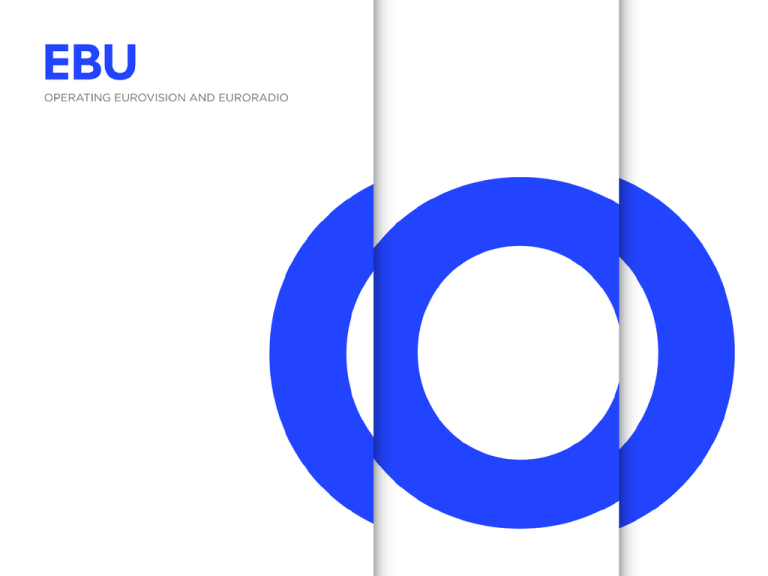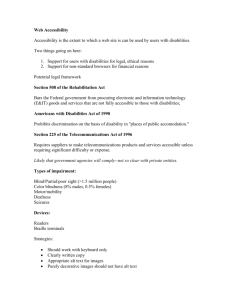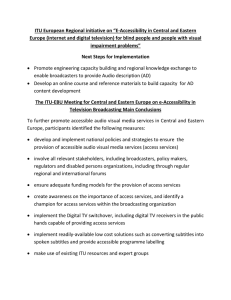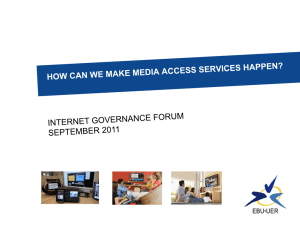Document 12956697
advertisement

The Power to Change Lives David Wood WBU/EBU Zagreb, December 2013 Some possible objectives for the meeting? • Discuss the need and options for access systems. • Examine relevant case studies. • Discuss options for possible ‘roadmap’ for access services • Discuss options for funding. • Prepare conclusions. • Your suggestions? Why do we all consume media? • To help us find our ‘identity • Where do I ‘fit’ in society? • Which groups do I belong to? • What is our national identity? • What is happening in the world? • Can I be diverted for a while? • Can I identify with characters in the drama? • What is the day to day information I need? •Those with disabilities can need these even more than those without disabilities. Audience Communities with Disabilities and Special Needs • • • • Blindness Deafness The Elderly Learning difficulties • • • • • Motor impairments Attention Deficit Disorder Autism Dyslexia Charge syndrome • • • • • • Cued Speech Spina Bifida Stuttering Traumatic Brain Injury Mental Handicap Gifted Means to serve the disabled communities using the media • Special programmes • Include portrayal of disabled people. • Greater involvement by the disabled in programme making and the media. • Measures to make all programmes more accessible • Society may have to ‘prioritize’ disabilities. The fact that ‘access services’ are an important ‘cause’ is clear. But broadcasters face funding dilemmas. Where should broadcasters best spend their funds and energy? • More and better access services for those with disabilities? • Greener broadcasting? • Transition to IT programme production? • Infrastructure for Internet delivery? • Transition to HDTV and UHDTV? • Higher cost majority programming? • More linguistic minority programming? Today we have a range of media delivery tools • • • • • • • • Normal (SDTV) broadcasting HDTV broadcasting Interactive broadcast applications FM and digital radio Broadband VoD Broadband interactive applications Mobile phones Broadcasting to handhelds Options today for Access Services • Broadcast Services • • • • • • Subtitles Audio Descriptions Audio local language sub-titles Signing overlay Clean audio (broadcast format) Radio to text conversion • Web services • Transcripts and playback – ‘script mining’ • Receiver features • • • • User-friendly receivers Audio rate control Clean audio (receiver format) Spoken programme guides And higher quality helps too.... • HDTV helps people with moderate sight disabilities • UHDTV will help even more • 3DTV brings to light correctable sight problems • The use of ‘loudness’ control helps audio descriptions and spoken subtitles.. One local example: Script mining using the web – developed in Slovenia There are many tools available, but... The menu needed for access services... • • • • The financial means to generate the service The staff skills needed, and ‘high quality’. The appropriate equipment in users hands Awareness of the services by users. The ‘business’ of media What makes media services successful? • • • • • • • The Old Factors Price Content available Furniture value Image/Sound Quality Usability Continuous Externalities • • • • • • The New Elements Playback failure Social context Contiguous Externalities Prior experiences/Expectations Personal skills available The Inactive Generation 34-to-David Wood years’ old The Interactive Generation 16-to-34 years’ old The starting new media problem: create a ‘virtuous circle’ Viewer experience Finance Media content Which finance model? Level 1 service Community at large. Conventional income (licence, grant, advertising). Level 2 service Significant groups. Partial funding from conventional income. Level 3 service Modest groups. Self financing. The UN Convention (UN CRPD) • Signatories “shall take appropriate measures to ensure that persons with disabilities enjoy access to television programmes, etc • FG-AVA interpretation: 1. Gradually make subtitling and audio descriptions available for all significant programmes over the next ten years. 2..Gradually make signing, audio rate control. Clean audio, and auxiliary text for radio over the next 15 years. The Power to Change Lives. • Today, media services make ‘some’ provisions for the disabled and elderly communities. • Either special programs can be made for these communities or programmes for the general audience can include features which help them to follow. • Both are needed, and welcomed, but could a global view of ‘Special Needs’ and the totality of media tools help? Are we doing as much as we could? Do we have the priorities right? • Technology and media has the power to change lives. Extract from FG-AVA reports “We observe that the greatest barrier today to the wider use of access systems is the lack of an economic basis for providing the services. Broadcasters and content providers need to be able to finance the provision of the services. Creative and innovative methods of doing so are needed.”





